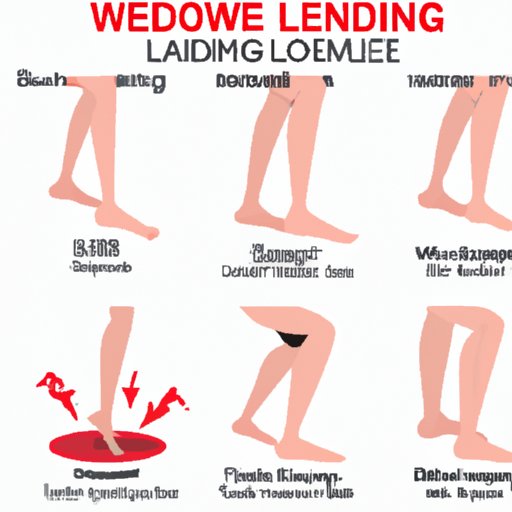
Introduction
Leg swelling is a common problem that can be caused by a variety of factors, including injury, surgery, prolonged standing or sitting, and underlying health conditions. In this article, we will explore various ways to reduce swelling in the legs, including home remedies, exercises, foods, clothing, and managing underlying conditions that cause leg swelling.
Home Remedies for Reducing Leg Swelling
Simple home remedies can be very effective in reducing leg swelling. Here are some of the most effective ones:
Cold Compresses
Applying a cold compress to the affected area can help reduce swelling by constricting blood vessels and reducing inflammation. To make a cold compress, wrap a few ice cubes in a towel and apply it to the swollen area for 15-20 minutes at a time, several times a day.
Elevation
Elevating the affected leg can also help reduce swelling. Lie down on your back with your legs elevated on a pillow or cushion so that they are higher than your heart. This will help improve circulation and reduce fluid buildup.
Massage
Massaging the affected area can help reduce swelling by improving circulation and promoting lymphatic drainage. Use gentle, circular motions to massage the affected area for a few minutes several times a day.
Compression Stockings
Wearing compression stockings can help prevent and reduce swelling by improving circulation and reducing fluid buildup. These stockings apply gentle pressure to the legs, promoting healthy blood flow and preventing fluid from accumulating in the tissues.
Simple Exercises to Relieve Swelling in Legs
Lack of movement or sitting or standing in one position for too long can cause swelling in the legs. Performing simple exercises can help alleviate swelling and discomfort in the legs. Here are some of the most beneficial exercises:
Ankle Rotations
Sit on a chair with your feet flat on the ground. Slowly rotate your ankles clockwise, then counterclockwise. Repeat for 10-15 repetitions on each ankle.
Toe Raises
Stand with your feet hip-width apart. Slowly rise up on your tiptoes, then lower your heels back down slowly. Repeat for 10-15 repetitions.
Calf Raises
Stand with your feet hip-width apart. Rise up on the balls of your feet, then lower yourself back down slowly. Repeat for 10-15 repetitions.
Leg Stretches
While sitting on a chair, extend your legs out in front of you. Point your toes upward, then bend them downward. Repeat for 10-15 repetitions.
Foods That Can Help Reduce Leg Swelling and Inflammation
Sometimes leg swelling can be caused or exacerbated by inflammation. Eating certain foods can help reduce inflammation and swelling in the legs. Here are some of the most effective foods:
Foods High in Potassium
Foods like bananas, avocados, sweet potatoes, and spinach are rich in potassium and can help regulate fluid balance in the body, reducing swelling and inflammation.
Foods Rich in Omega-3 Fatty Acids
Foods like fatty fish, walnuts, chia seeds, and flaxseeds are rich in omega-3 fatty acids, which can help reduce inflammation and swelling in the body.
Spices and Herbs with Anti-inflammatory Properties
Spices and herbs like turmeric, ginger, cinnamon, and garlic have anti-inflammatory properties and can help reduce swelling and inflammation in the body.
Foods with Diuretic Effects
Foods like celery, cucumbers, watermelon, and melons have natural diuretic effects, which can help reduce fluid buildup and swelling in the body.
Clothing and Footwear to Prevent Leg Swelling
Wearing the right clothing and footwear can help prevent leg swelling. Here are some tips:
Loose-Fitting Clothes
Avoid wearing tight clothes that can restrict blood flow and cause fluid accumulation in the legs. Wear loose-fitting clothes that allow for comfortable movement.
Comfortable Shoes with Proper Arch Support
Wearing comfortable shoes with proper arch support can help prevent leg swelling by improving circulation and reducing pressure on the feet and legs.
Compression Sleeves or Socks
If you experience swelling frequently, wearing compression sleeves or socks can help keep the fluids circulating in the legs and prevent buildup that leads to swelling and discomfort.
Managing Underlying Conditions That Cause Leg Swelling
In some cases, leg swelling can be a symptom of an underlying health condition. Managing these conditions appropriately can help reduce swelling in the legs. Here are some of the underlying conditions that can cause leg swelling:
Heart Disease and Edema
Heart diseases, like congestive heart failure, can cause fluid buildup and swelling in the legs. Managing the underlying heart condition, taking prescribed medications, and reducing salt intake can help manage edema and swelling.
Venous Insufficiency and Leg Ulcers
Vein damage can cause fluid buildup and swelling in the legs, leading to the development of leg ulcers. Compression therapy, leg elevation, wound dressings, and antibiotics can help in managing venous insufficiency and leg ulcers.
Lymphedema
Lymphedema is a condition that occurs when the lymphatic system doesn’t function properly. It causes fluid buildup and swelling in the legs. Compression therapy, manual lymph drainage therapy, specific exercises, and healthy habits like proper skin care can help manage swelling caused by lymphedema.
Diabetes and Circulatory Problems
Diabetes and circulatory problems increase the risk of leg swelling. Proper management of blood sugar levels, a healthy diet, regular exercise, and sticking to the prescribed medication can prevent and manage swelling in the legs.
Conclusion
Leg swelling can be a painful and uncomfortable condition. In this article, we explored various remedies that can help reduce leg swelling, including home remedies, exercises, foods, clothing, and managing underlying conditions that cause leg swelling. It is essential to try different strategies to find what works best for you and avoid potential complications. Remember to seek medical attention if swelling persists or worsens. Manage any underlying conditions that can contribute to leg swelling, and lead a healthy, active lifestyle.





